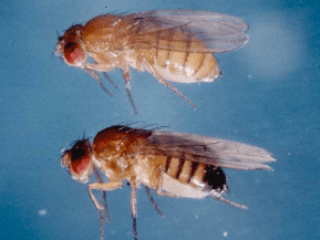
It is not the strongest of the species that survives, or the most intelligent ; it is the one most capable of change
Mots clés: Plasticité phénotypique, Biologie de l'invasion, Température, Drosophila

Phenotypic plasticity and adaptive responses to environmental change
My research work has allowed me to explore different aspects concerning the adaptive responses of organisms to environmental changes, mainly temperature, on the insect model and especially on Drosophila through a comparative approach. I was particularly interested in phenotypic plasticity which can be defined as the ability of a genotype to produce different phenotypes according to environmental conditions. Phenotypic plasticity is a phenomenon that can be generalized to all living organisms and that can be found in all species and for a wide variety of phenotypic traits.
The main questions addressed during my research are :
How to analyze the shapes of non-linear reaction norms? Do these reaction norms present genetic variability? How do these norms evolve between populations and between species? Do these comparisons provide arguments for adaptive phenotypic plasticity?
How will environmental variability (thermal fluctuation) impact the shape of response norms? What about environmental complexity (combination of several factors)?
What is the importance of phenotypic plasticity as a response mechanism to environmental perturbations?
On this issue, I am coordinating the ANR TRAPP project, which started on January 1, 2025 for 4 years and involves two LBBE teams (GEI and ECE), the CASPER unit of Anses in Lyon and the Institut de Génétique Humaine in Montpellier. Agriculture and vector control programs make intensive use of chemical insecticides to control insect pests and disease vectors. They represent a major selection pressure for insect populations.
Transgenerational plasticity (TGP) is a form of non-genetic inheritance in which a change in the phenotype of offspring is triggered by an environmental signal in the parental generation without involving genetic modification. The existence of the TGP process is no longer disputed, but many questions remain, notably concerning the molecular mechanisms of these intergenerational effects and the persistence of TGP over more than two generations. In this project, we propose to use the experimental power offered by Drosophila melanogaster, a model species in physiology, developmental biology and genetics, to explore TGP in response to insecticides. Molecular mechanisms linked to TGP, particularly epigenetics, will be studied. This species can also be considered a sentinel species, representative of insect species exposed to contaminants in most agroecosystems, such as the Drosophila sp. community and the related pest species D. suzukii, but observations can probably be generalized to other arthropods. The study of the transgenerational impacts of insecticides is still little taken into account in insecticide risk assessment.

Drosophila suzukii: a recent biological invasion and a major economic threat
For the past few years, my research activity has focused on a project concerning a very recent biological invasion event involving a fruit crop pest, Drosophila suzukii. At the fundamental level, we were first interested in the ecological factors that explain the invasive success of this species whose biology was poorly known. We showed that French larval parasitoids were unable to control D. suzukii populations because of its very high immune resistance capacity. We also showed that this species has a very wide range of wild host plants present throughout the year and we highlighted an interesting case of self-medication in D. suzukii. Moreover, our results suggest that if D. suzukii does not really have competitors on healthy fruits, it can undergo a strong larval competition with D. melanogaster on rotten fruits on which an oviposition avoidance behavior is observed. Current projects aim to use the recent and spectacular invasion of D. suzukii to better understand the mechanisms of adaptation to a new environment, in particular the role of phenotypic plasticity. Finally, some projects have also been developed to consider new control methods against this formidable crop pest.
Marie Panza's thesis, which I am co-supervising with Laurence Mouton (LBBE) and Vincent Foray (IRBI Tours), focuses on the resistance capacity of the crop pest Drosophila suzukii to a parasitoid recently introduced into France, Leptopilina japonica. To this end, we propose a three-part study: 1) To characterize the variation in resistance to L. japonica between invasive European populations of D. suzukii and look for potential trade-offs with fitness-related traits. 2) Test the influence of environment and microbiota on D. suzukii resistance to L. japonica. This part will focus on the effect of the nutrient environment and the heritable bacterium Wolbachia. 3) Identify the proximal factors underlying variation in resistance to L. japonica. This analysis will investigate the molecular mechanisms underlying intra-specific variation in D. suzukii, but also inter-specific variation between D. suzukii and another Drosophila species, D. melanogaster. From a fundamental point of view, this study will contribute to our understanding of the ultimate and proximal factors involved in host-parasitoid resistance variation. From an applied point of view, it will provide valuable results for the development of a biological control program against D. suzukii and the assessment of risks of resistance emergence. This project is being carried out in close collaboration with our colleagues in the Biological Control Research and Development team at ISA Sophia Antipolis.
Physiological basis of insect community responses to climate change
This collaborative project is led by Cameron Ghalambor (Professor) Norwegian University of Science and Technology, Norwayhttps://www.ntnu.edu/employees/cameron.ghalambor
The earth's climate is evolving rapidly, leading to observable changes in the abundance and geographical distribution of insects. These changing climatic conditions could lead to a global decline or, on the contrary, the growth of certain insect species. Insects play an important role in ecosystem functioning, crop pollination and disease transmission, so understanding the causes of these changes is an important issue for biodiversity, agriculture and human health. To date, our understanding of insect physiological responses to climate change is based mainly on thermodynamic and energetic responses to temperature. However, the integration of the combined effects of temperature on water loss and desiccation risk is important to consider. Insects are particularly vulnerable to desiccation due to their small size and limited water storage capacity. They lose water as the temperature rises across the surface of their cuticle and through high respiration rates.Research has shown that the thermal sensitivity of water loss and metabolism varies from species to species, but no study to date has attempted to systematically describe these patterns in insect groups and in climates varying in temperature and precipitation. We propose to fill this gap by investigating the thermal sensitivity of metabolic rate and water loss in insect species from different climates in Europe. We will combine these data with climate projection models to build new models for predicting how species will respond to future conditions.
Responsabilités
- Membre du Conseil Scientifique du CNRS depuis octobre 2023
- Coresponsable du Living Lab Anthares au sein du PEPR SOLU-BIOD depuis 2023
- Membre de la commission interdisciplinaire 50 ‘Gestion de la Recherche’– 2022-2025.
-
Membre de la Commission scientifique Sciences Exactes et Naturelles-4 (SEN-4) et de la Commission scientifique Sustainability du F.R.S.-FNRS depuis 2022.
Publications
Display of 1 to 30 publications on 116 in total
Continent-wide differentiation of fitness traits and patterns of climate adaptation among European populations of Drosophila melanogaster
Evolution Letters . : qraf014
Journal article
see the publicationHow does ageing affect life history traits and cold tolerance in summer‐versus winter‐acclimated fruit flies?
Ecological Entomology . 50 ( 4 ) : 655-669
DOI: 10.1111/een.13437
Journal article
see the publicationExploring the role of transposable elements to sex gap in longevity in Drosophila species
Preprint
see the publicationFootprints of Worldwide Adaptation in Structured Populations of Drosophila melanogaster Through the Expanded DEST 2.0 Genomic Resource
Molecular Biology and Evolution . 42 ( 8 ) : msaf132
Journal article
see the publicationContribution of variable TE content on phenotype and plasticity in Drosophila melanogaster.
Annual meeting of the Society of Molecular Biology and Evolution (SMBE) .
Conference paper
see the publicationContribution of variable TE content on phenotype and plasticity in Drosophila melanogaster.
Conférence Jacques Monod Life is plastic .
Conference paper
see the publicationContribution of variable TE content on phenotype and plasticity in Drosophila melanogaster
International congress of transposable elements .
Poster
see the publicationProjet DS2 : Drosophila suzukii « Développer des Stratégies de gestion efficaces, économiquement viables et durables »
Innovations Agronomiques . 94 : 127-140
Journal article
see the publicationModelling thermal reaction norms for development and viability in Drosophila suzukii under constant, fluctuating and field conditions
Journal of Thermal Biology . 123 : 103891
Journal article
see the publicationPoster de présentation du living lab Antharès - Réseau de living labs Solu-Biod
Lancement officiel du Programme national de recherche sur les Solutions fondées sur la Nature .
Poster
see the publicationA synthesis of biological invasion hypotheses associated with the introduction–naturalisation–invasion continuum
Oikos . 5 ( 5 ) : e09645
DOI: 10.1111/oik.09645
Journal article
see the publicationMicrobiota-mediated competition between Drosophila species
Microbiome . 11 : 201
Journal article
see the publicationLarval density in the invasive Drosophila suzukii : Immediate and delayed effects on life‐history traits
Ecology and Evolution . 13 ( 8 ) : e10433
DOI: 10.1002/ece3.10433
Journal article
see the publicationThermal plasticity of insecticide sensitivity in an invasive pest species
SFE2 GfÖ EEF Joint meeting, International Conference on Ecological Sciences “Ecology and Evolution: New perspective and societal challenges .
Conference paper
see the publicationSterile Insect Technique: Principles, Deployment and Prospects
Extended Biocontrol . : 55-67
Book chapter
see the publicationLarval density in the invasive Drosophila suzukii : immediate and delayed effects on life-history traits
Preprint
see the publicationDifferentiation of thermal reaction norms between marginal and core populations of a northward expanding parasitoid
Preprint
see the publicationMacroecological patterns of fruit infestation rates by the invasive fly Drosophila suzukii in the wild reservoir host plant Sambucus nigra
Agricultural and Forest Entomology . 24 ( 4 ) : 548-563
DOI: 10.1111/afe.12520
Journal article
see the publicationMacroecological Patterns of Fruit Infestation Rates by the Invasive Fly Drosophila suzukii in the Reservoir Host Plant Sambucus nigra
1st International Electronic Conference on Biological Diversity, Ecology and Evolution . : 9469
Conference paper
see the publicationDetection and monitoring of Drosophila suzukii in raspberry and cherry orchards with volatile organic compounds in the USA and Europe
Scientific Reports . 11 ( 1 )
Journal article
see the publicationThe Worldwide Invasion of Drosophila suzukii Is Accompanied by a Large Increase of Transposable Element Load and a Small Number of Putatively Adaptive Insertions
Molecular Biology and Evolution . 38 ( 10 ) : 4252-4267
Journal article
see the publicationPhenotypic and Transcriptomic Responses to Stress Differ According to Population Geography in an Invasive Species
Genome Biology and Evolution . 13 ( 9 ) : evab208
DOI: 10.1093/gbe/evab208
Journal article
see the publicationGenetic Variability, Population Differentiation, and Correlations for Thermal Tolerance Indices in the Minute Wasp, Trichogramma cacoeciae
Insects . 12 ( 11 ) : 1013
Journal article
see the publicationChapitre 5. Principes, mise en œuvre et perspectives de la technique de l’insecte stérile
Biocontrôle. Éléments pour une protection agroécologique des cultures . 9782759230761 : 75-87
Book chapter
see the publicationGenomic Analysis of European Drosophila melanogaster Populations Reveals Longitudinal Structure, Continent-Wide Selection, and Previously Unknown DNA Viruses
Molecular Biology and Evolution . 37 ( 9 ) : 2661-2678
Journal article
see the publicationBiological Invasion: The Influence of the Hidden Side of the (Epi)Genome
Functional Ecology . 34 ( 2 ) : 385-400
Journal article
see the publicationDrosophila suzukii oxidative stress response involves Jheh gene cluster but not transposable elements
Preprint
see the publicationBiological Invasion Theories: Merging Perspectives from Population, Community and Ecosystem Scales
Biological Reviews .
Preprint
see the publicationPhenotypic plasticity in the invasive pest Drosophila suzukii: activity rhythms and gene expression in response to temperature
Journal of Experimental Biology . 222 : jeb199398
DOI: 10.1242/jeb.199398
Journal article
see the publicationPhenotypic plasticity, global change, and the speed of adaptive evolution
Current Opinion in Insect Science . 35 : 34-40
Journal article
see the publication